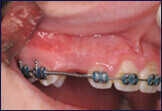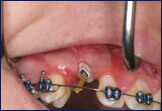Canine Exposure

During the course of orthodontic treatment, sometimes certain teeth fail to naturally erupt into place. A surgical exposure of a tooth facilitates its eruption and allows the orthodontic treatment to be completed in a timely manner. In most cases, the canine teeth need to be surgically exposed due to delayed eruption.
Why would a canine not erupt into place when it is supposed to?
There are many theories, but oftentimes the canine does not move into place because the enzymes that usually dissolve the bone ahead of the crown of the tooth fail to do so. In fact, the canine frequently is encased in bone, stuck in a state of immobility.
The canine can be impacted either on the cheek side or the roof-of-the-mouth side (the palate). X-rays can help the surgeon determine which approach to take.
The procedure involves getting the area anesthetized, making an incision and reflecting the gum tissue, and removing any bone that is surrounding the crown of the canine.
An orthodontic bracket is bonded into place and tied to the patient's archwire, and the gum tissue flap is repositioned and fixated with dissolvable sutures.
The surgical site is usually sore for 24-48 hours, and medications will be prescribed to alleviate any discomfort experienced. A week follow-up is needed to ensure proper healing.
The surgical exposure of a canine or any other tooth is a necessary procedure to allow timely eruption.

